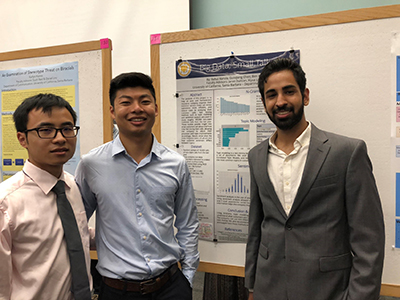By Ian Duncan
The Department of Statistics and Applied Probability at the University of California, Santa Barbara (UCSB) offers a unique course—Research Projects in Actuarial Science (PSTAT 296 A-B)—to its Actuarial Masters (and some undergraduate, by invitation) students. The course, which is now eight years old, started with three students; the last class numbered 28, divided into nine teams.
The department applied for and was awarded an education grant from the SOA under the CAE Grants Program in 2015. The grant allowed us to hire two post-doctoral students for three years (with additional support from the university) as instructors for the course, working with the regular faculty. I have been the principal instructor for the course since 2014, with support from my wife, Janet Duncan, FSA, FCAS, MAAA. We provide a broad range of topic coverage: Janet is a P&C actuary and I am primarily a health actuary with some life insurance experience and considerable experience in predictive modeling. Recently we have also had the support of the financial mathematics faculty. This broad range of experience allows us to work with a wide range of industry sponsors.
The course is designed to expose students to real-world research problems related to the insurance industry. Projects and data are provided by our industry research partners, and students are trained in scientific writing, presentation skills, realistic data analysis, Excel, R and SAS programming. The course emphasizes group teamwork and regular interaction with faculty and industry sponsors. In return, sponsoring companies benefit from resulting research and access to UCSB’s 300+ actuarial majors and faculty. Employers are impressed both with the quality of research work, but more importantly with the fact that students have been exposed to real-world problems and real-world data. Students who have participated in the course are snapped-up by employers at graduation.
Depending on the number of projects, typically each project team includes 3–4 students. It is a required sequence for masters’ students pursuing the combined five-year B.S. / M.S. degree in Actuarial Science. Some students pursuing MA in Applied Statistics participate as well. Typically, students in the Actuarial Research Projects class have taken applied statistics courses in regression, time series and data mining, as well as actuarial courses in compound interest, actuarial statistics, financial mathematics, etc. They have working knowledge of SAS, R and at least one additional programming language, typically C++ and Python.
The course requires intense preparation on the part of the faculty, who are responsible for finding research partners, projects and datasets, and for guiding student teams in weekly meetings. Students prepare weekly reports on the work that they have completed in the prior week. In many cases regular conference calls are held with industry sponsors to educate the students on the backgrounds to their projects, address data issues and present ongoing results. Students are also required to present to the entire class and to the actuarial and financial mathematics faculty at the mid-point and end of each quarter. Presentations teach students public speaking and writing skills as well as requiring them to think on their feet to respond to faculty questions. All projects are presented as posters at the annual Undergraduate Research Colloquium at UCSB, and students submit a final report (sometimes in the form of a research paper) to faculty at the end of the course. In one instance students developed a valuation model as well.
Best projects are submitted for presentation at the annual Actuarial Research Conference. Frequently, the students also make an on-site visit and presentation to the industry partner. Students have visited California State Automobile Association in Walnut Creek, California State Association of Counties—Excess Insurance Association in Sacramento, the William Sansum Diabetes Clinic in Santa Barbara, and Santa Barbara Cottage Hospital. Students made presentations via webcast to sponsors that we were unable to visit in person. Our students have won best-presenter or best poster at almost all the Actuarial Research Conferences that they have attended. Several student projects have led to peer-reviewed publications as well, including “Testing Alternative Regression Frameworks for Predictive Modeling of Health Care Costs.” 1
The CAE Education Grant
The unique nature of this course was a factor in awarding a CAE Education Grant to UCSB. A requirement of the grant is that we make available the materials for a minimum of three research projects annually, so that interested faculty at other universities may use the materials, and, if necessary, the “road-map” from our projects to guide their own student research. A website is available for faculty use that provides a package of materials: a project description, references and readings, a week-by-week guide to assignments, a dataset, R code, a PowerPoint presentation and a final report. The site includes descriptions of the different projects that are available to faculty. Descriptions of the projects available and details for accessing the information can be found on the website.
We would be delighted to discuss our course and the research packages with any interested faculty and are ready to respond to questions and provide other support as necessary.

Students Guojiang Chen, Ben Ku and Rahul Narula with their poster: Big Data, Small Talk, at the UC, Santa Barbara Undergraduate Research Colloquium, May 2018.
1Ludkovski, M., I. Duncan and M. Loginov. 2016. Testing Alternative Regression Frameworks for Predictive Modeling of Health Care Costs. North American Actuarial Journal. 20(1), winner of the Brockett-Shapiro Prize of the American Risk and Insurance Association, 2018.